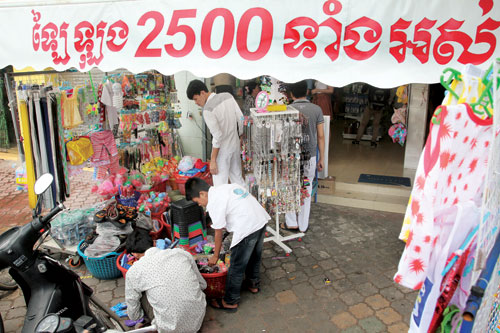Discount shops attracting crowds
Discount shops attracting crowds
Two thousand five hundred – for Mom Dalin, this is more than just a random number or the price of a coffee, it is her way of making a living.

The 55-year-old sits at a small desk in her son’s shop on Sihanouk Boulevard, within sight of the Independence Monument, and asks a customer to pay for a pair of Angry Birds underpants, sunglasses and a pencil. She rings up a bill of less than $2.
Dalin works in a so-called 2,500 Riel retail shop, where everything – from cosmetics to kitchenware to children clothes – costs, well, you get the idea. She says the cheap price tag attracts hundreds of customers every day.
“The demand for daily products is going up,” Dalin says. “We import the same commodities as traditional markets do, but our cheaper prices give us an advantage.”
Dalin’s experience is far from unique. The number of “Mart 2,500 Riel” or “Mart 60 Cent” shops – 2,500 riel is actually about 62.5 cents, but why quibble? – has skyrocketed in Phnom Penh over the last couple of years, due to an expanding economy and a growing middle class.
But while it brings profits to the shops, it can hurt small business vendors in traditional markets by undercutting them.
“The proposition of ‘one price for all’ is loaded with a prospect that makes for a good deal, Karl Johan Remoy, acting general manager of Indochina Research (Cambodia) Ltd, said. The customer’s mindset is “I will probably find something”, he added.
The proposition, however, should be tailored to the market.
“One dollar shops have been around for years, even in Cambodia, but while $1 has been working in developing markets, it seems to have been asking too much of the Cambodian consumer,” he said. “In contrast, 2,500 riel is what you pay for a cup of coffee, a Coke, a bowl of rice or noodles. When a number of new categories are entered into this price range it becomes intriguing to find out just how much you can get for 2,500 riel.” Cambodia is undergoing economic growth and people have more money to spend.
“The role of the traditional market will most certainly change. More money in circulation will stimulate demand for products and services, but it will be increasingly difficult for individual vendors to compete with high volume retailers who can negotiate far better deals with their suppliers," Remoy said.
Researchers from the International Labour Organization in Geneva estimate that in 2004, about 642,000 or 9.8 per cent of all Cambodian workers were middle class and above, meaning they were living on $4 or more a day.
That figure increased to 1.2 million or 16.1 per cent in 2008 and is projected to rise to 2.8 million or 31.6 per cent by 2017.
As people discover the range of products they can access, word of mouth spreads. Entrepreneurs looking to start a business have caught on, too.
Chhor Keang Thai, 28, stands in his shop near the Olympic Stadium. His parents run a business, but the idea to join the trend and open up a 2,500 riel shop came from his relatives, who own five shops in Phnom Penh.
Like Dalin, he says middle-class and even wealthy Cambodians come to his store regularly.
Srey Leak, a 25-five-year-old customer in the Sihanouk Boulevard shop, stands next to the cosmetics section. She says she comes often because she can buy “a lot of cute things” and it’s not expensive.
She says the quality is the same as she would get in traditional markets, but the price is lower and the environment is “nicer”. On average, she says she spends $10 per purchase.
No hard figures are available of how many 2,500 riel shops exist in Phnom Penh. But Dalin, who sold fried rice, noodles and ice-cream at a food stall in Dreamland before, estimates there are about 100 of them in the city.
She says new merchandise – all produced in China and Thailand – are delivered at least once, sometimes twice a day, costing her about $500 per shipment. With a monthly rent of $1,000, her expenditures are high.
But she says business is going well.
Especially in the evening, her store is packed and customers sometimes stay until midnight or 2am. On average, people spend $10 in her shop.
Thai plans to expand. He says he is in discussion with a house owner to open his second shop. “I am happy to see it is growing,” he says. “[But] I have become thinner since I established this shop, because I am very busy.”
Remoy, with Indochina Research Cambodia, said: “There are good deals to be made. A shop owner can accept lower margins as long as he can sell a higher volume and increase the speed of stock turnover.
“The shop will typically have a good bargain for a popular product category to attract the crowd, once the customer is in the shop he ends up buying into other categories where the margins are more favourable to the shop owner – for the shopper who is already in the shop it is now a question of convenience.”
phnompenh post













